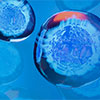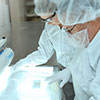chromatography+columns+HyClone+products+(Cytiva)
Catalog Number:
(10110-922)
Supplier:
Prosci
Description:
UBQLN3 is an ubiquitin-like protein (ubiquilin) that shares high degree of similarity with related products in yeast, rat and frog. Ubiquilins contain a N-terminal ubiquitin-like domain and a C-terminal ubiquitin-associated domain. They physically associate with both proteasomes and ubiquitin ligases, and thus thought to functionally link the ubiquitination machinery to the proteasome to affect in vivo protein degradation. UBQLN3 is specifically expressed in the testis, and proposed to regulate cell-cycle progression during spermatogenesis. This gene encodes an ubiquitin-like protein (ubiquilin) that shares high degree of similarity with related products in yeast, rat and frog. Ubiquilins contain a N-terminal ubiquitin-like domain and a C-terminal ubiquitin-associated domain. They physically associate with both proteasomes and ubiquitin ligases, and thus thought to functionally link the ubiquitination machinery to the proteasome to affect in vivo protein degradation. This gene is specifically expressed in the testis, and proposed to regulate cell-cycle progression during spermatogenesis.
Catalog Number:
(10103-864)
Supplier:
Prosci
Description:
ADA is an enzyme that catalyzes the hydrolysis of adenosine to inosine. Various mutations have been described for this gene and have been linked to human diseases. Deficiency in this enzyme causes a form of severe combined immunodeficiency disease (SCID), in which there is dysfunction of both B and T lymphocytes with impaired cellular immunity and decreased production of immunoglobulins, whereas elevated levels of this enzyme have been associated with congenital hemolytic anemia.This gene encodes an enzyme that catalyzes the hydrolysis of adenosine to inosine. Various mutations have been described for this gene and have been linked to human diseases. Deficiency in this enzyme causes a form of severe combined immunodeficiency disease (SCID), in which there is dysfunction of both B and T lymphocytes with impaired cellular immunity and decreased production of immunoglobulins, whereas elevated levels of this enzyme have been associated with congenital hemolytic anemia. Publication Note: This RefSeq record includes a subset of the publications that are available for this gene. Please see the Entrez Gene record to access additional publications.
Catalog Number:
(10102-836)
Supplier:
Prosci
Description:
G6PC hydrolyzes glucose-6-phosphate to glucose in the endoplasmic reticulum.It forms with the glucose-6-phosphate transporter (SLC37A4/G6PT) the complex responsible for glucose production through glycogenolysis and gluconeogenesis. Hence, it is the key enzyme in homeostatic regulation of blood glucose levels.Glucose-6-phosphatase is an integral membrane protein of the endoplasmic reticulum that catalyzes the hydrolysis of D-glucose 6-phosphate to D-glucose and orthophosphate. It is a key enzyme in glucose homeostasis, functioning in gluconeogenesis and glycogenolysis. Defects in the enzyme cause glycogen storage disease type I (von Gierke disease). Publication Note: This RefSeq record includes a subset of the publications that are available for this gene. Please see the Entrez Gene record to access additional publications.
Catalog Number:
(89358-998)
Supplier:
Genetex
Description:
ADP-ribosylation factor 5 (ARF5) is a member of the human ARF gene family. These genes encode small guanine nucleotide-binding proteins that stimulate the ADP-ribosyltransferase activity of cholera toxin and play a role in vesicular trafficking and as activators of phospholipase D. The gene products include 6 ARF proteins and 11 ARF-like proteins and constitute 1 family of the RAS superfamily. The ARF proteins are categorized as class I (ARF1, ARF2,and ARF3), class II (ARF4 and ARF5) and class III (ARF6). The members of each class share a common gene organization. The ARF5 gene spans approximately 3.2kb of genomic DNA and contains six exons and five introns. [provided by RefSeq]
Catalog Number:
(10102-550)
Supplier:
Prosci
Description:
CA8 was initially named CA-related protein because of sequence similarity to other known carbonic anhydrase genes. However, CA8 lacks carbonic anhydrase activity (i.e., the reversible hydration of carbon dioxide). CA8 continues to carry a carbonic anhydrase designation based on clear sequence identity to other members of the carbonic anhydrase gene family. The protein encoded by this gene was initially named CA-related protein because of sequence similarity to other known carbonic anhydrase genes. However, the gene product lacks carbonic anhydrase activity (i.e., the reversible hydration of carbon dioxide). The gene product continues to carry a carbonic anhydrase designation based on clear sequence identity to other members of the carbonic anhydrase gene family. The absence of CA8 gene transcription in the cerebellum of the lurcher mutant in mice with a neurologic defect suggests an important role for this acatalytic form.
Supplier:
GE Healthcare - Life Sciences
Description:
Capto SP ImpRes is a strong cation exchange BioProcess medium, designed to meet the demands of modern large-scale manufacturers for fast, efficient, and cost-effective intermediate and polishing protein purification.
Catalog Number:
(10108-684)
Supplier:
Prosci
Description:
CHGA is a member of the chromogranin/secretogranin family of neuroendocrine secretory proteins. It is found in secretory vesicles of neurons and endocrine cells. Its gene's product is a precursor to three biologically active peptides; vasostatin, pancreastatin, and parastatin. These peptides act as autocrine or paracrine negative modulators of the neuroendocrine system. Other peptides, including chromostatin, beta-granin, WE-14 and GE-25, are also derived from the full-length protein. However, biological activities for these molecules have not been shown.The protein encoded by this gene is a member of the chromogranin/secretogranin family of neuroendocrine secretory proteins. It is found in secretory vesicles of neurons and endocrine cells. This gene product is a precursor to three biologically active peptides; vasostatin, pancreastatin, and parastatin. These peptides act as autocrine or paracrine negative modulators of the neuroendocrine system. Other peptides, including chromostatin, beta-granin, WE-14 and GE-25, are also derived from the full-length protein. However, biological activities for these molecules have not been shown.
Catalog Number:
(10105-032)
Supplier:
Prosci
Description:
NFATC4 is a member of the nuclear factors of activated T cells DNA-binding transcription complex. This complex consists of at least two components: a preexisting cytosolic component that translocates to the nucleus upon T cell receptor (TCR) stimulation and an inducible nuclear component. Other members of this family of nuclear factors of activated T cells also participate in the formation of this complex. NFATC4 plays a role in the inducible expression of cytokine genes in T cells, especially in the induction of the IL-2 and IL-4.The product of this gene is a member of the nuclear factors of activated T cells DNA-binding transcription complex. This complex consists of at least two components: a preexisting cytosolic component that translocates to the nucleus upon T cell receptor (TCR) stimulation and an inducible nuclear component. Other members of this family of nuclear factors of activated T cells also participate in the formation of this complex. The product of this gene plays a role in the inducible expression of cytokine genes in T cells, especially in the induction of the IL-2 and IL-4.
Catalog Number:
(10104-072)
Supplier:
Prosci
Description:
KLC3 is a member of the kinesin light chain gene family. Kinesins are molecular motors involved in the transport of cargo along microtubules, and are composed of two kinesin heavy chain (KHC) and two kinesin light chain (KLC) molecules. KLCs are thought to typically be involved in binding cargo and regulating kinesin activity. In the rat, a protein similar to this gene product is expressed in post-meiotic spermatids, where it associates with structural components of sperm tails and mitochondria.This gene encodes a member of the kinesin light chain gene family. Kinesins are molecular motors involved in the transport of cargo along microtubules, and are composed of two kinesin heavy chain (KHC) and two kinesin light chain (KLC) molecules. KLCs are thought to typically be involved in binding cargo and regulating kinesin activity. In the rat, a protein similar to this gene product is expressed in post-meiotic spermatids, where it associates with structural components of sperm tails and mitochondria.
Catalog Number:
(10100-342)
Supplier:
Prosci
Description:
The aldehyde dehydrogenases are a family of isozymes that may play a major role in the detoxification of aldehydes generated by alcohol metabolism and lipid peroxidation. ALDH3B1 is highly expressed in kidney and lung. The aldehyde dehydrogenases are a family of isozymes that may play a major role in the detoxification of aldehydes generated by alcohol metabolism and lipid peroxidation. This particular gene spans about 20 kb of genomic DNA and is composed of 9 coding exons. The gene encodes a single transcript of 2.8 kb which is highly expressed in kidney and lung. The functional significance of this gene as well as the cellular localization of its product are presently unknown. Two transcript variants encoding different isoforms have been found for this gene.
Catalog Number:
(CA016-0202)
Supplier:
Rockland Immunochemical
Description:
Produced through a multi-stage process that includes delipidation, salt fractionation, ion-exchange chromatography, gel filtration, and affinity chromatography. No contaminating proteins are observed when assayed at a protein concentration of 20mg/mL against anti-whole serum or anti-fragment specific antisera. All immunoglobulin fragments are prepared from highly purified, whole molecules subject to enzymatic digestion.
Catalog Number:
(10100-818)
Supplier:
Prosci
Description:
NFKB has been detected in numerous cell types that express cytokines, chemokines, growth factors, cell adhesion molecules, and some acute phase proteins in health and in various disease states. NFKB is activated by a wide variety of stimuli such as cytokines, oxidant-free radicals, inhaled particles, ultraviolet irradiation, and bacterial or viral products. Inappropriate activation of NF-kappa-B has been linked to inflammatory events associated with autoimmune arthritis, asthma, septic shock, lung fibrosis, glomerulonephritis, atherosclerosis, and AIDS. In contrast, complete and persistent inhibition of NF-kappa-B has been linked directly to apoptosis, inappropriate immune cell development, and delayed cell growth.
Catalog Number:
(10103-838)
Supplier:
Prosci
Description:
P2RY12 belongs to the family of G-protein coupled receptors. This family has several receptor subtypes with different pharmacological selectivity, which overlaps in some cases, for various adenosine and uridine nucleotides. This receptor is involved in platelets aggregation, and is a potential target for the treatment of thromboembolisms and other clotting disorders.The product of this gene belongs to the family of G-protein coupled receptors. This family has several receptor subtypes with different pharmacological selectivity, which overlaps in some cases, for various adenosine and uridine nucleotides. This receptor is involved in platelets aggregation, and is a potential target for the treatment of thromboembolisms and other clotting disorders. Two transcript variants encoding the same isoform have been identified for this gene.
Catalog Number:
(10101-588)
Supplier:
Prosci
Description:
The TCL7L2 is a high mobility group (HMG) box-containing transcription factor implicated in blood glucose homeostasis. The study of Yi et al. suggested that TCL7L2 acts through regulation of proglucagon through repression of the proglucagon gene in enteroendocrine cells via the Wnt signaling pathway. The TCL7L2 gene product is a high mobility group (HMG) box-containing transcription factor implicated in blood glucose homeostasis. The study of Yi et al. (2005) [PubMed 15525634] suggested that TCL7L2 acts through regulation of proglucagon (MIM 138030) through repression of the proglucagon gene in enteroendocrine cells via the Wnt signaling pathway.
Catalog Number:
(89359-082)
Supplier:
Genetex
Description:
Component of the THO subcomplex of the TREX complex. The TREX complex specifically associates with spliced mRNA and not with unspliced pre-mRNA. It is recruited to spliced mRNAs by a transcription-independent mechanism. Binds to mRNA upstream of the exon-junction complex (EJC) and is recruited in a splicing- and cap-dependent manner to a region near the 5' end of the mRNA where it functions in mRNA export. The recruitment occurs via an interaction between THOC4 and the cap-binding protein NCBP1. UAP56 functions as a bridge between THOC4 and the THO complex. The TREX complex is essential for the export of Kaposi's sarcoma-associated herpesvirus (KSHV) intronless mRNAs and infectious virus production. The recruitment of the TREX complex to the intronless viral mRNA occurs via an interaction between KSHV ORF57 protein and THOC4.
Catalog Number:
(10109-098)
Supplier:
Prosci
Description:
LNX1 is a membrane-bound protein that is involved in signal transduction and protein interactions. LNX1 is an E3 ubiquitin-protein ligase, which mediates ubiquitination and subsequent proteasomal degradation of proteins containing phosphotyrosine binding (PTB) domains. This protein may play an important role in tumorogenesis.This gene encodes a membrane-bound protein that is involved in signal transduction and protein interactions. The encoded product is an E3 ubiquitin-protein ligase, which mediates ubiquitination and subsequent proteasomal degradation of proteins containing phosphotyrosine binding (PTB) domains. This protein may play an important role in tumorogenesis. Alternatively spliced transcript variants encoding distinct isoforms have been described. A pseudogene, which is located on chromosome 17, has been identified for this gene.
Inquire for Price
Stock for this item is limited, but may be available in a warehouse close to you. Please make sure that you are logged in to the site so that available stock can be displayed. If the
Stock for this item is limited, but may be available in a warehouse close to you. Please make sure that you are logged in to the site so that available stock can be displayed. If the
You must log in to order restricted items. We request that you provide the required business documentation to purchase this product for the first time.
To order chemicals, medical devices, or other restricted products please provide identification that includes your business name and shipping address via email CMD_NA@vwr.com or fax 484.881.5997 referencing your VWR account number . Acceptable forms of identification are:
-Additional Documentation May be needed to purchase this item. A VWR representative will contact you if needed.
This product has been blocked by your organization. Please contact your purchasing department for more information.
The original product is no longer available. The replacement shown is available.
This product is currently unavailable but limited stock may be available in our extended warehouse network. Please call 1-800-932-5000 and a VWR Customer Service Representative will help you.
|
|||||||||


































